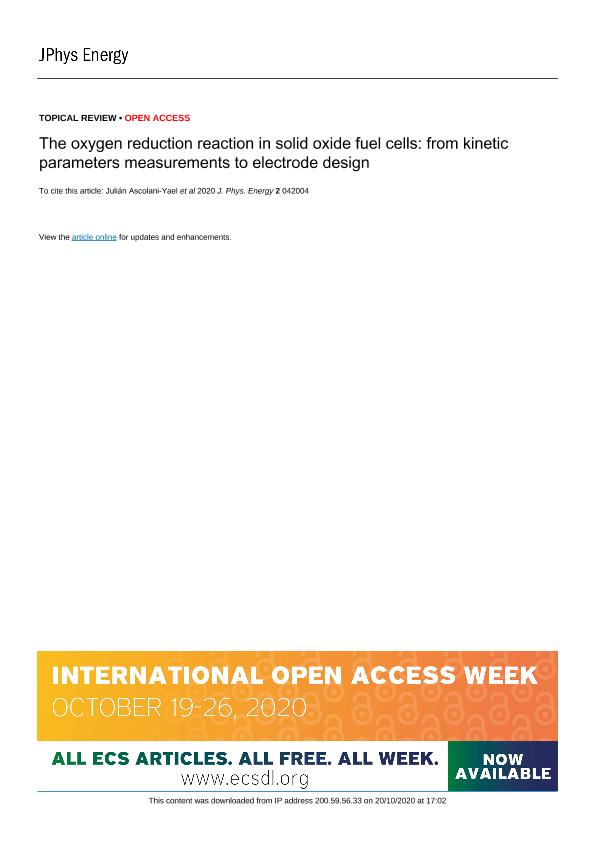Mostrar el registro sencillo del ítem
dc.contributor.author
Ascolani Yael, Julian Esteban

dc.contributor.author
Montenegro Hernandez, Alejandra

dc.contributor.author
Garcés, Diana Andrea

dc.contributor.author
Liu, Quinyuan
dc.contributor.author
Wang, Hongqian
dc.contributor.author
Yakal Kremski, Kyle
dc.contributor.author
Barnett, Scott
dc.contributor.author
Mogni, Liliana Verónica

dc.date.available
2021-11-11T12:01:20Z
dc.date.issued
2020-10
dc.identifier.citation
Ascolani Yael, Julian Esteban; Montenegro Hernandez, Alejandra; Garcés, Diana Andrea; Liu, Quinyuan; Wang, Hongqian; et al.; The oxygen reduction reaction in solid oxide fuel cells: From kinetic parameters measurements to electrode design; IOP Publishing; JPhys Energy; 2; 4; 10-2020; 1-29
dc.identifier.issn
2515-7655
dc.identifier.uri
http://hdl.handle.net/11336/146662
dc.description.abstract
The research and development of new Solid Oxide Fuel Cell cathode materials is an area of intense activity. The kinetic coefficients describing the O2-reduction mechanism are the O-ion diffusion (Dchem) and the O-surface exchange coefficients (kchem). These parameters are strongly dependent on the nature of the material, both on its bulk and surface atomic and electronic structures. This review discusses the method for obtaining the kinetic coefficients through the combination of electrochemical impedance spectroscopy with focused ion-beam 3D tomography measurements on porous electrodes (3DT-EIS). The data, together with oxygen non-stoichiometry thermodynamic data, is analysed using the Adler-Lane-Steele model for macro-homogeneous porous electrodes. The results for different families of oxides are compared: single- and double-layered perovskites with O-vacancies defects, based on La-Sr cobalt ferrites (La0.6Sr0.4Co1-xFexO3-δ, x = 0.2 and 0.8) and La/Pr-Ba cobaltites (La0.5-xPrxBa0.5CoO3-δ, x = 0.0, 0.2 and 0.5), as well as Ruddlesden-Popper nickelates (Nd2NiO4 +δ) with O-interstitial defects. The analysis of the evolution of molar surface exchange rates with oxygen partial pressure provides information about the mechanisms limiting the O2-surface reaction, which generally is dissociative adsorption or dissociation-limited. At 700 ◦C in air, the La-Ba cobaltite structures, La0.5-xPrxBa0.5CoO3-δ, feature the most active surfaces (kchem≃0.5-1 10−2 cm.s−1), followed by the nickelate Nd2NiO4 +δ and the La-Sr cobalt ferrites, with kchem≃1-5 10−5 cm.s−1. The diffusion coefficients Dchem are higher for cubic perovskites than for the layered ones. For La0.6Sr0.4Co0.8Fe0.2O3-δ and La0.6Sr0.4Co0.2Fe0.8O3-δ, Dchem is 2.6 10−6 cm2.s−1 and 5.4 10−7 cm2.s−1, respectively. These values are comparable to Dchem = 1.2 10−6 cm2.s−1, observed for La0.5Ba0.5CoO3-δ. The layered structure drastically reduces the O-ion bulk diffusion, e.g. Dchem = 1.3 10−8 cm2.s−1 for the Pr0.5Ba0.5CoO3-δ double perovskite and Dchem≃2 10−7cm2.s−1 for Nd2NiO4 +δ. Finally, the analysis of the time evolution of the electrodes shows that the surface cation segregation affects both the O-ion bulk diffusion and the surface exchange rates.
dc.format
application/pdf
dc.language.iso
eng
dc.publisher
IOP Publishing

dc.rights
info:eu-repo/semantics/openAccess
dc.rights.uri
https://creativecommons.org/licenses/by/2.5/ar/
dc.subject
CATHODE
dc.subject
O-ION DIFFUSION COEFFICIENT
dc.subject
SOLID OXIDE FUEL CELL
dc.subject
SURFACE EXCHANGE
dc.subject.classification
Cerámicos

dc.subject.classification
Ingeniería de los Materiales

dc.subject.classification
INGENIERÍAS Y TECNOLOGÍAS

dc.title
The oxygen reduction reaction in solid oxide fuel cells: From kinetic parameters measurements to electrode design
dc.type
info:eu-repo/semantics/article
dc.type
info:ar-repo/semantics/artículo
dc.type
info:eu-repo/semantics/publishedVersion
dc.date.updated
2021-10-20T18:21:16Z
dc.journal.volume
2
dc.journal.number
4
dc.journal.pagination
1-29
dc.journal.pais
Reino Unido

dc.description.fil
Fil: Ascolani Yael, Julian Esteban. Consejo Nacional de Investigaciones Cientificas y Tecnicas. Oficina de Coordinacion Administrativa Ciudad Universitaria. Unidad Ejecutora Instituto de Nanociencia y Nanotecnologia. Unidad Ejecutora Instituto de Nanociencia y Nanotecnologia - Nodo Bariloche | Comision Nacional de Energia Atomica. Unidad Ejecutora Instituto de Nanociencia y Nanotecnologia. Unidad Ejecutora Instituto de Nanociencia y Nanotecnologia - Nodo Bariloche.; Argentina
dc.description.fil
Fil: Montenegro Hernandez, Alejandra. Consejo Nacional de Investigaciones Cientificas y Tecnicas. Oficina de Coordinacion Administrativa Ciudad Universitaria. Unidad Ejecutora Instituto de Nanociencia y Nanotecnologia. Unidad Ejecutora Instituto de Nanociencia y Nanotecnologia - Nodo Bariloche | Comision Nacional de Energia Atomica. Unidad Ejecutora Instituto de Nanociencia y Nanotecnologia. Unidad Ejecutora Instituto de Nanociencia y Nanotecnologia - Nodo Bariloche.; Argentina
dc.description.fil
Fil: Garcés, Diana Andrea. Consejo Nacional de Investigaciones Científicas y Técnicas. Oficina de Coordinación Administrativa Ciudad Universitaria. Unidad Ejecutora Instituto de Nanociencia y Nanotecnología. Unidad Ejecutora Instituto de Nanociencia y Nanotecnología - Nodo Constituyentes | Comisión Nacional de Energía Atómica. Unidad Ejecutora Instituto de Nanociencia y Nanotecnología. Unidad Ejecutora Instituto de Nanociencia y Nanotecnología - Nodo Constituyentes; Argentina
dc.description.fil
Fil: Liu, Quinyuan. Northwestern University; Estados Unidos
dc.description.fil
Fil: Wang, Hongqian. Northwestern University; Estados Unidos
dc.description.fil
Fil: Yakal Kremski, Kyle. Northwestern University; Estados Unidos
dc.description.fil
Fil: Barnett, Scott. Northwestern University; Estados Unidos
dc.description.fil
Fil: Mogni, Liliana Verónica. Consejo Nacional de Investigaciones Cientificas y Tecnicas. Oficina de Coordinacion Administrativa Ciudad Universitaria. Unidad Ejecutora Instituto de Nanociencia y Nanotecnologia. Unidad Ejecutora Instituto de Nanociencia y Nanotecnologia - Nodo Bariloche | Comision Nacional de Energia Atomica. Unidad Ejecutora Instituto de Nanociencia y Nanotecnologia. Unidad Ejecutora Instituto de Nanociencia y Nanotecnologia - Nodo Bariloche.; Argentina
dc.journal.title
JPhys Energy
dc.relation.alternativeid
info:eu-repo/semantics/altIdentifier/url/https://iopscience.iop.org/article/10.1088/2515-7655/abb4ec
dc.relation.alternativeid
info:eu-repo/semantics/altIdentifier/doi/http://dx.doi.org/10.1088/2515-7655/abb4ec
Archivos asociados
